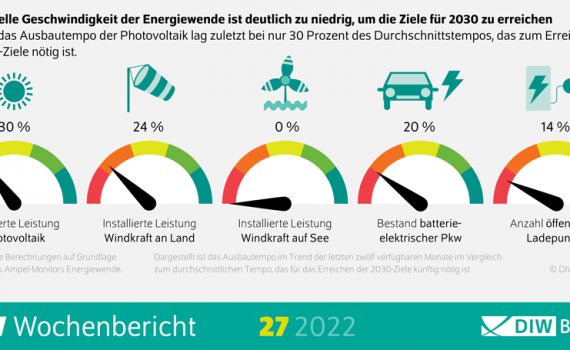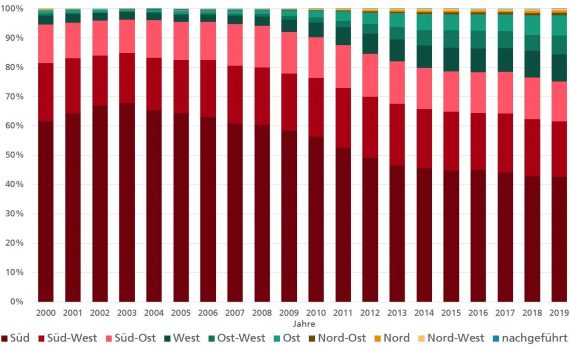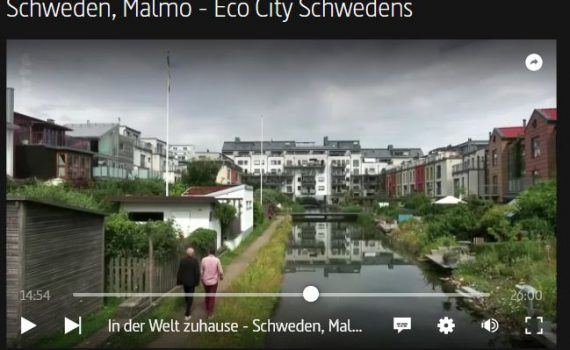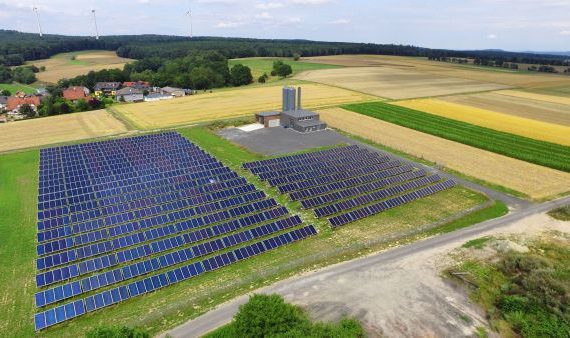Die EU-Staaten haben endgültig grünes Licht für die überarbeitete Richtlinie zur Energieeffizienz von Gebäuden gegeben und die neuen Vorgaben formell beschlossen. Kadri Simson, EU-Kommissarin für Energie, begrüßte das Votum: „Eine bessere Gesamtenergieeffizienz von Gebäuden ist von entscheidender Bedeutung, um unser Ziel der Klimaneutralität zu erreichen und die Energieunabhängigkeit Europas zu stärken. Renovierungen sind Investitionen in eine bessere Zukunft.“
Kategorie für Blog: Renewable
 Net public electricity generation reached a record share of 59.7 per cent in 2023. The share of the load was 57.1 per cent. This is the result of an analysis presented today by the Fraunhofer Institute for Solar Energy Systems ISE. New records were set for wind and solar power in 2023. In contrast, generation from lignite (-27 per cent) and hard coal (-35 per cent) fell sharply. Photovoltaics stood out in the expansion of generation capacity: at around 14 gigawatts, the expansion was in double digits for the first time and significantly exceeded the German government's statutory climate protection target.
Net public electricity generation reached a record share of 59.7 per cent in 2023. The share of the load was 57.1 per cent. This is the result of an analysis presented today by the Fraunhofer Institute for Solar Energy Systems ISE. New records were set for wind and solar power in 2023. In contrast, generation from lignite (-27 per cent) and hard coal (-35 per cent) fell sharply. Photovoltaics stood out in the expansion of generation capacity: at around 14 gigawatts, the expansion was in double digits for the first time and significantly exceeded the German government's statutory climate protection target.
More rail transport, reformed motor vehicle tax and less fossil heating needed
 Germany can still achieve its climate targets by 2030. This is shown in a new analysis by the Federal Environment Agency (UBA). This would require, among other things, more rail transport, a reform of the motor vehicle tax and the restriction of fossil heating. In addition, all emissions would have to be priced and charged to the polluter. In the so-called Climate Protection Instruments Scenario 2030 (KIS-2030), the UBA has examined how additional emissions can be saved in the building, mobility, energy and industry sectors. "The model calculation clearly shows that we have a lot of catching up to do in some sectors," says UBA President Dirk Messner. "We now urgently need a constructive dialogue about where emissions can be reduced, otherwise we will miss the legal savings targets. We also need to talk honestly about how to cushion the financial burden on lower-income groups and distribute it more fairly. Currently, low-income households are often asked to pay disproportionately. Understandably, this does not exactly increase acceptance for more climate protection.
Germany can still achieve its climate targets by 2030. This is shown in a new analysis by the Federal Environment Agency (UBA). This would require, among other things, more rail transport, a reform of the motor vehicle tax and the restriction of fossil heating. In addition, all emissions would have to be priced and charged to the polluter. In the so-called Climate Protection Instruments Scenario 2030 (KIS-2030), the UBA has examined how additional emissions can be saved in the building, mobility, energy and industry sectors. "The model calculation clearly shows that we have a lot of catching up to do in some sectors," says UBA President Dirk Messner. "We now urgently need a constructive dialogue about where emissions can be reduced, otherwise we will miss the legal savings targets. We also need to talk honestly about how to cushion the financial burden on lower-income groups and distribute it more fairly. Currently, low-income households are often asked to pay disproportionately. Understandably, this does not exactly increase acceptance for more climate protection.
Scientific scenarios on climate neutrality support corporate strategy and planning on the path to decarbonisation - Using the example of buildings and heating, climate economists at DIW Berlin analyse existing scenarios on climate neutrality - Net zero scenarios show a clear path for the transformation of companies and the financial sector - With standardised scenarios and transition plans for climate neutrality, banks, funds and insurance companies can make their portfolios fit for the future.
On 16 June, the member states of the European Union approved a comprehensive revision of the EU Renewable Energy Directive (RED) in the Committee of Permanent Representatives. The European target for renewable energies will thus be significantly increased from the previous 32% to 45% in 2030. This means a doubling of the share of renewable energy compared to the level reached in 2021 of just under 22%. This is a great success for the expansion of renewables: It roughly doubles the planned expansion of renewable energy by 2030. To achieve the new targets, more than 100 GW of new wind turbines and solar installations will be installed in the EU every year. For Germany, this means that the significantly increased expansion targets for wind and solar energy in 2022 will be underpinned by European targets and become binding. The higher EU targets also form the framework for further measures and targets in the EU, such as the EU's solar strategy, which aims to roughly triple PV capacity to 600 GW by 2030.
PV strategy presented
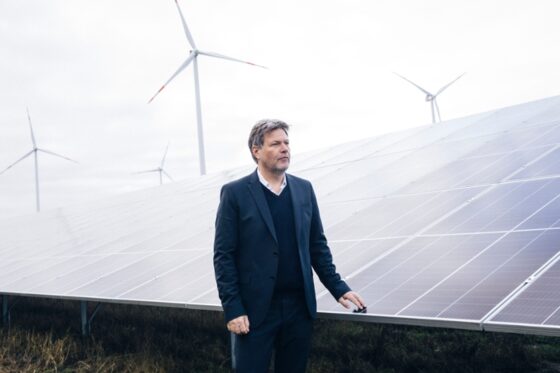 Today, Federal Minister of Economics and Climate Protection Robert Habeck presented the second PV-The aim is to significantly accelerate the expansion of solar energy in Germany. The goal is to significantly accelerate the expansion of solar energy in Germany. To this end, the strategy identifies measures in a total of eleven fields of action. The spectrum ranges from measures in the area of energy policy to the topics of securing skilled labour, industrial value creation in Europe and technology development. This was preceded by a first photovoltaic summit in March 2023. Since March, the PV strategy has been consulted. More than 600 comments were received.
Today, Federal Minister of Economics and Climate Protection Robert Habeck presented the second PV-The aim is to significantly accelerate the expansion of solar energy in Germany. The goal is to significantly accelerate the expansion of solar energy in Germany. To this end, the strategy identifies measures in a total of eleven fields of action. The spectrum ranges from measures in the area of energy policy to the topics of securing skilled labour, industrial value creation in Europe and technology development. This was preceded by a first photovoltaic summit in March 2023. Since March, the PV strategy has been consulted. More than 600 comments were received.- One third of homeowners plan to install in the next twelve months
- High electricity prices fuel demand for cheap solar energy
- Online survey of 1,000 people - representative survey by age and gender
Proven work aid and at the same time standard work for climate protection work in municipalities can be used digitally in future. Difu, ifeu and Climate Alliance developed the guide on behalf of the BMWK.
The housing shortage is an immense social problem in many large cities and conurbations. At the same time, the building sector has been failing to meet its environmental and climate targets for years. In a recent position paper, the Federal Environment Agency (UBA) and the Commission for Sustainable Building at the UBA (KNBau) have examined how more affordable housing can be created without unnecessarily harming the environment and health. According to this paper, the most important factor for more environmental protection in housing construction is that the existing building stock is preserved wherever possible or is sensibly converted and repurposed. This is the easiest way to avoid climate emissions and unnecessarily high consumption of raw materials. Today, UBA President Prof. Dr. Dirk Messner presented KNBau's proposals to Federal Minister of Building Klara Geywitz and Federal Minister of the Environment Steffi Lemke in Berlin.
Researchers at DIW Berlin have developed the "Ampel-Monitor Energiewende" - monitor the extent to which the government's energy policy agenda is being implemented - immense efforts are needed to close the gap between the announced targets and the current status quo
Thüga closed the 2021 financial year with a good result. The approximately 100 municipal utilities and regional suppliers of the Thüga Group fully fulfilled their supply mandate and continued to drive forward the energy turnaround despite burdensome general conditions.
Is German climate policy on the right path? A national CO2 budget for Germany allows for a transparent comparison with international targets. In a paper published today, the Environmental Council updates its calculations for a German CO2 budget, showing that fast emission reductions are crucial - last year, climate targets for transport and buildings were missed again. The paper also answers frequently asked questions about the CO2 budget.
Germanwatch now urgently expects political signals following the conclusion of the interim technical negotiations / Special challenge on the issue of damage and loss recognised, now it is a matter of concrete financing proposals
More and more companies, but also private households, are using the sun's energy to generate electricity: In March 2022, 2.2 million photovoltaic systems with a total nominal output of 58,400 megawatts were installed on roofs and properties. As reported by the Federal Statistical Office (Destatis), the number of systems thus increased by 10.1 % compared to the same month of the previous year, while the installed capacity rose by 9.7 % within a year. In January 2018, when the figure was first collected, there had been a good 1.7 million installations with a nominal capacity of 42,300 megawatts. Since then, the number of turbines has risen by just under 34.0 %, while installed capacity has increased by 38.3 %.
The cities propose to strengthen and accelerate local climate protection through a new financial support system. The German Association of Cities today published a concept and a publication on its website.
Recommendations from the BMBF project "Urban Heat Transition" were published: ► Consistently tapping alternative heat sources such as wastewater heat ► Convert public buildings to renewable heat and create neighbourhood heating networks ► Ambitious energy refurbishment in neighbourhood conservation areas to keep rents affordable
 The Federal Cabinet today adopted the so-called Easter Package at the proposal of Vice Chancellor and Federal Minister for Economic Affairs and Climate Protection Robert Habeck. This is the largest amendment to energy policy legislation in decades. The Easter Package comprehensively amends various energy laws in order to accelerate and consistently drive forward the expansion of renewable energies.
The Federal Cabinet today adopted the so-called Easter Package at the proposal of Vice Chancellor and Federal Minister for Economic Affairs and Climate Protection Robert Habeck. This is the largest amendment to energy policy legislation in decades. The Easter Package comprehensively amends various energy laws in order to accelerate and consistently drive forward the expansion of renewable energies.
 After a significant decline in the previous year, greenhouse gas emissions in Germany are on the rise again. Thus, around 762 million tonnes of greenhouse gases were released in 2021 - a good 33 million tonnes or 4.5 percent more than in 2020. Overall, emissions in Germany have thus fallen by 38.7 percent since 1990. The increase in the last year is particularly noticeable in the energy sector: This shows an increase of 27 million tonnes CO2-equivalents, as increased demand for electricity, lower electricity generation from renewable energies and the higher gas price led to increased use of coal for electricity generation. Electricity generation from renewables fell by seven per cent, mainly due to poor wind conditions. In the transport and building sectors, emissions were above the annual ceilings set by the Federal Climate Protection Act. This is shown by the latest calculations of the Federal Environment Agency (UBA), which are based on the specifications of the Federal Climate Protection Act and the EU-Renewable Energy Directive (RED) were presented today.
After a significant decline in the previous year, greenhouse gas emissions in Germany are on the rise again. Thus, around 762 million tonnes of greenhouse gases were released in 2021 - a good 33 million tonnes or 4.5 percent more than in 2020. Overall, emissions in Germany have thus fallen by 38.7 percent since 1990. The increase in the last year is particularly noticeable in the energy sector: This shows an increase of 27 million tonnes CO2-equivalents, as increased demand for electricity, lower electricity generation from renewable energies and the higher gas price led to increased use of coal for electricity generation. Electricity generation from renewables fell by seven per cent, mainly due to poor wind conditions. In the transport and building sectors, emissions were above the annual ceilings set by the Federal Climate Protection Act. This is shown by the latest calculations of the Federal Environment Agency (UBA), which are based on the specifications of the Federal Climate Protection Act and the EU-Renewable Energy Directive (RED) were presented today.
 Fig.: Naturstrom AG
NATURSTROM is expanding its largest local heating project to date in Markt Erlbach, Franconia. In future, the green energy supplier will supply over 130 customers with sustainable and locally generated heat - including households, municipal buildings and a large commercial enterprise. Bavaria's largest solar thermal plant is being built on an area of 2,400 m2 for this purpose.
Fig.: Naturstrom AG
NATURSTROM is expanding its largest local heating project to date in Markt Erlbach, Franconia. In future, the green energy supplier will supply over 130 customers with sustainable and locally generated heat - including households, municipal buildings and a large commercial enterprise. Bavaria's largest solar thermal plant is being built on an area of 2,400 m2 for this purpose.
The property developer WvM Immobilien + Projektentwicklung GmbH and the eco-energy supplier NATURSTROM AG found the joint company Green Estate. With the fusion of energy and real estate know-how, the partners are taking a new path to enable people to live sustainably.
Sascha Müller-Kraenner, Federal Director of Deutsche Umwelthilfe (DUH), comments on today's debate on the Renewable Energy Sources Act (EEG) in the Bundestag: "The Grand Coalition is breaking its promise to set higher expansion targets for renewable energies for the year 2030 before the end of this legislative period. An agreement failed primarily due to the energy transition obstructionists within the CDU/CSU parliamentary group. The German government is thus ignoring the implementation of the new EU climate targets and disregarding the decision of the Federal Constitutional Court to tackle more ambitious climate protection measures before 2030. The amendment to the Renewable Energy Sources Act is missing the centrepiece. At the end of 2020, Federal Minister for Economic Affairs Peter Altmaier announced an ambitious expansion path for wind and solar energy for the first quarter of 2021. After a long wait, there was only the famous drop in the ocean: four gigawatts of onshore wind energy and six gigawatts of photovoltaics are the targets for 2022. Longer-term expansion targets? Not a chance. Clearly, the need for a rapid transformation of our energy supply has not yet been recognised by the CDU/CSU, despite all their climate protection commitments during the election campaign."
 In a recently written short study, scientists from the Department of Energy System Analysis at the Fraunhofer Institute for Solar Energy Systems ISE prepared an evaluation of the Market Master Data Register (MaStR) and the EEG system master data for photovoltaics (PV). Important findings of the analyses were that with 38 percent of the newly installed capacity, the increase in capacity in Germany is increasingly taking place in the segment of rooftop systems larger than 100 kW, 22 percent of the newly built PV systems are erected in a west, east or east-west direction and 19 percent of these systems have tilt angles smaller than 20 degrees.
In a recently written short study, scientists from the Department of Energy System Analysis at the Fraunhofer Institute for Solar Energy Systems ISE prepared an evaluation of the Market Master Data Register (MaStR) and the EEG system master data for photovoltaics (PV). Important findings of the analyses were that with 38 percent of the newly installed capacity, the increase in capacity in Germany is increasingly taking place in the segment of rooftop systems larger than 100 kW, 22 percent of the newly built PV systems are erected in a west, east or east-west direction and 19 percent of these systems have tilt angles smaller than 20 degrees.
 "New large-scale construction projects and ecological innovations have ensured that Malmö is now a prime example of the direct transition from an industrial metropolis to a sustainable eco city. The secret recipe: the city not only relied on innovative technologies, but above all on the active participation of citizens in the transformation."
"New large-scale construction projects and ecological innovations have ensured that Malmö is now a prime example of the direct transition from an industrial metropolis to a sustainable eco city. The secret recipe: the city not only relied on innovative technologies, but above all on the active participation of citizens in the transformation."
On 22.12.2020, the Senate passed the first legal ordinance on the Hamburg Climate Protection Act. This regulates the concrete implementation of the solar roof obligation and the integration of renewable energies when replacing heating systems. With these regulations, Hamburg is one of the pioneers in climate protection in the building sector nationwide.
A new study from Denmark takes a look at the costs of sustainable building construction and shows that more sustainable does not automatically mean more expensive. On the contrary. The study by Buus Consult on behalf of the DGNB system partner from Denmark, the Green Building Council Denmark, now provides clarity. In the study, it takes a close look at 37 DGNB-certified buildings.
 In the context of the Green Deal, the EU's tightened targets on the path to climate neutrality envisage a reduction in CO2 emissions of 55% by 2030 and 100% by 2050. Against the background of these tightened parameters, the question arises as to the impact on the energy transition in Germany. Based on its energy system model REMod, Fraunhofer ISE has calculated the consequences of the new EU targets for the expansion of renewable energies in Germany and now presents the results in a short study.
In the context of the Green Deal, the EU's tightened targets on the path to climate neutrality envisage a reduction in CO2 emissions of 55% by 2030 and 100% by 2050. Against the background of these tightened parameters, the question arises as to the impact on the energy transition in Germany. Based on its energy system model REMod, Fraunhofer ISE has calculated the consequences of the new EU targets for the expansion of renewable energies in Germany and now presents the results in a short study.
Emissions targets, some of them significantly improved, show effectiveness of Paris Agreement / But too few commitments for financing climate protection and adaptation to climate change in poorer countries / Chancellor Merkel must swiftly launch international process for additional climate financing
 With the portal https://energiewendedörfer.de the University of Kassel and Georg-August-Universität Göttingen will present the initial results from the joint project "Innovative concepts and business models for sustainable bioenergy villages - climate-friendly, democratic, citizen-centred". In particular, concepts are being developed for bioenergy and biogas plants that can enable continued economic operation after the current 20-year EEG phase.
With the portal https://energiewendedörfer.de the University of Kassel and Georg-August-Universität Göttingen will present the initial results from the joint project "Innovative concepts and business models for sustainable bioenergy villages - climate-friendly, democratic, citizen-centred". In particular, concepts are being developed for bioenergy and biogas plants that can enable continued economic operation after the current 20-year EEG phase.

 The German Solar Energy Society e.V. (DGS) and the energy advice service of the consumer advice centre have been cooperating with each other since 1 December 2020. Consumer enquiries from both institutions are answered by the energy advisors of the consumer advice centre. In return, the DGS trains the advisors of the consumer advice centre in the subject area of plug-in solar devices.
The German Solar Energy Society e.V. (DGS) and the energy advice service of the consumer advice centre have been cooperating with each other since 1 December 2020. Consumer enquiries from both institutions are answered by the energy advisors of the consumer advice centre. In return, the DGS trains the advisors of the consumer advice centre in the subject area of plug-in solar devices.
 The state of Lower Saxony has launched a new funding programme for battery storage systems. The funding guideline was published in the Lower Saxony Ministerial Gazette on 21 October. Applications can be submitted to the NBank with immediate effect.
The subsidy of up to 40 per cent of the net investment costs of a battery storage system applies in connection with the new construction or expansion of PV systems (at least 4 kWp). In addition to natural persons, grant recipients can also be companies, legal entities, local authorities and many others.
The state of Lower Saxony has launched a new funding programme for battery storage systems. The funding guideline was published in the Lower Saxony Ministerial Gazette on 21 October. Applications can be submitted to the NBank with immediate effect.
The subsidy of up to 40 per cent of the net investment costs of a battery storage system applies in connection with the new construction or expansion of PV systems (at least 4 kWp). In addition to natural persons, grant recipients can also be companies, legal entities, local authorities and many others.





